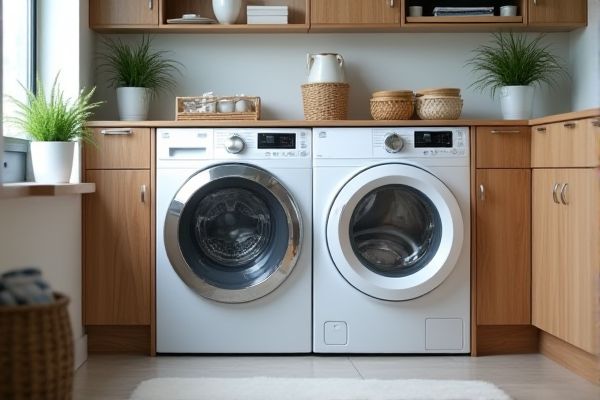
High-efficiency washers use less water and energy than regular washers, providing better cleaning performance while saving utility costs and reducing environmental impact. Explore the rest of this article to discover which washer type best suits your laundry needs and home efficiency goals.
Table of Comparison
| Feature | High-Efficiency Washer | Regular Washer |
|---|---|---|
| Water Usage | Uses 60-80% less water per load | Uses more water, larger volumes per load |
| Energy Consumption | Lower energy use, Energy Star rated | Higher energy consumption |
| Wash Cycle Time | Longer cycles for thorough cleaning | Shorter cycles |
| Detergent Requirement | Requires HE detergent (low-sudsing) | Standard detergent |
| Clothing Care | Gentler on fabrics due to tumbler action | Can be harsher on clothes |
| Load Capacity | Often larger capacity | Usually smaller capacity |
| Price | Higher initial cost | Lower upfront cost |
| Spin Speed | Faster spin speeds, reduces drying time | Slower spin speeds |
| Environmental Impact | Reduced water and energy footprint | Higher environmental impact |
Introduction to High-Efficiency vs Regular Washers
High-efficiency (HE) washers use advanced technology to significantly reduce water and energy consumption compared to regular washers, making them more environmentally friendly and cost-effective. HE washers utilize faster spin cycles and specialized detergents to improve cleaning performance while minimizing resource use. Regular washers typically consume more water and energy per cycle, resulting in higher utility costs and environmental impact.
How High-Efficiency Washers Work
High-efficiency washers use advanced technology, such as sensors and judicious water distribution, to optimize washing cycles by using less water and energy compared to regular washers. They employ a tumbling motion instead of an agitator to gently clean clothes while preserving fabric quality and reducing wear and tear. These washers also feature longer wash cycles with lower water levels, enabling improved detergent activation and efficient soil removal.
Key Features of Regular Washers
Regular washers operate with a central agitator that moves clothes through water to remove dirt, using more water and energy compared to high-efficiency models. They typically have shorter wash cycles and rely on higher water levels to soak and rinse laundry effectively. These washers often come at a lower upfront cost, making them accessible but less eco-friendly due to higher resource consumption.
Water and Energy Consumption Comparison
High-efficiency washers use up to 50% less water and 25% less energy compared to regular washers by employing advanced technology and faster spin cycles that extract more water from clothes. Your utility bills can decrease significantly due to reduced water usage and shorter wash cycles. Choosing a high-efficiency washer supports environmental sustainability by lowering your household's overall water and energy footprint.
Cleaning Performance: Efficiency vs Traditional
High-efficiency washers use advanced technology such as tumbling and lower water levels to achieve superior cleaning performance compared to traditional washers. These machines remove more dirt and stains while using up to 70% less water, enhancing both cleanliness and environmental efficiency. Regular washers rely on agitators and larger water volumes, which can be less effective at stain removal and overall soil extraction.
Detergent Use and Compatibility
High-efficiency washers require specially formulated low-sudsing detergents designed to work with less water, ensuring optimal cleaning performance and preventing excess residue buildup. Regular washers use standard detergents that produce more suds and may lead to over-sudsing if used in high-efficiency machines. Your choice of detergent directly impacts the efficiency and longevity of your washer, as using incompatible detergent can cause mechanical issues and reduce cleaning effectiveness.
Initial Cost and Long-term Savings
High-efficiency washers typically have a higher initial cost ranging from $800 to $1,500 compared to regular washers priced between $400 and $700. Despite the upfront expense, high-efficiency washers reduce water and energy consumption by approximately 20-50%, leading to significant long-term savings on utility bills. Over time, these savings can offset the initial investment, making high-efficiency washers more cost-effective than regular models.
Noise Levels and Cycle Duration
High-efficiency washers operate with significantly lower noise levels due to advanced motor technology and reduced water usage, making them ideal for quiet home environments. Cycle duration in high-efficiency washers tends to be longer, often ranging from 45 to 90 minutes, as they use precise water levels and slower spin speeds to maximize cleaning efficiency and fabric care. Regular washers produce more noise from agitators and faster water filling, with shorter cycles typically lasting 30 to 50 minutes, though they consume more water and energy.
Maintenance and Longevity
High-efficiency (HE) washers require regular cleaning of filters and detergent dispensers to prevent clogs, ensuring optimal performance and extending their lifespan. Regular washers often demand less specialized maintenance but may suffer from faster wear due to inefficient water usage and higher mechanical stress. Your choice impacts long-term durability, with HE washers generally offering better energy savings and longer service life when properly maintained.
Which Washer Is Right for Your Home?
High-efficiency washers use significantly less water and energy compared to regular washers, making them ideal for eco-conscious households aiming to reduce utility bills and environmental impact. Regular washers typically have shorter wash cycles and can handle larger loads quickly, which may be preferable for homes with frequent, large laundry demands. Consider your water usage, laundry volume, and energy efficiency priorities to determine which washer fits best with your home's needs.
 homyna.com
homyna.com